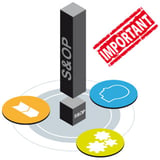The Importance of Inventory Optimization in Lean Supply Chains
Nick Ostdick - May 03, 2016

 Imagine walking into a clothing store to buy a new pair of pants. A salesman takes your measurements, asks about your wants and desires for the pants, and then goes into the back of the store and makes your new pants catered to your exacting specifications - size, color, material, and style. You leave the store feeling satisfied, happy, and confident future orders will be fulfilled in much the same manner.
Imagine walking into a clothing store to buy a new pair of pants. A salesman takes your measurements, asks about your wants and desires for the pants, and then goes into the back of the store and makes your new pants catered to your exacting specifications - size, color, material, and style. You leave the store feeling satisfied, happy, and confident future orders will be fulfilled in much the same manner.
Perfect world, right? Unfortunately, we don’t live in a perfect world. Lead times, production schedules, order changes, variant-rich manufacturing cycles, and more can leave companies struggling to navigate the complexities of global demand and supply management. These companies require powerful tools and strategies to create lean supply networks and practices, particularly inventory optimization (IO), which should be a top priority for any company.
The core principle behind IO software and strategy is what allowed our fictional clothes shopping experience to run so smoothly. The salesman had to know what materials he had on hand, in what quantity, where they were located, how they should best be allocated, and what backup plans were in place in case of shortages in completing our order.
This enhanced level of visibility and transparency into supply and production capabilities is a key driver for companies in leveraging IO strategy, and supply planners and managers need to strive for this value-added level of detail to remain competitive and profitable in today’s diversifying supply industry.
Why IO?
Simply put, IO is the process by which planners and managers ensure the right materials are in the right place at the right time to leverage the best in production capabilities and efficiency. Lean supply chain principles are all about eliminating as much waste as possible across all points of the supply stream, and inventory overages, shortages, or disruptions are a big part of that reduction in wasted or misallocated resources.
Perhaps this sounds simple, but many companies today still do not operate with a coordinated, centralized IO strategy or software solution. Instead, companies allow various units within their organization to manage their own inventories under spreadsheet-based principles which can negatively impact production schedules and cycles, transportation and deliverability of products, and communication between global trading partners.
Imagine an automotive company operates a production facility in Mexico and that facility loses power for a day. Production is suspended, which then creates massive shortages at critical points in this company’s North American supply network. Now, if this company has implemented an IO strategy, planners would be able to examine current inventory levels at the Mexico facility - as well as other facilities throughout North America and across the globe - and execute quick, data-based decisions and adjustments based on production constraints or restrictions to combat product shortages until the plant is operational.
Because this company functions with an IO solution, all this can be done in real-time with instantaneous communication, coordination, and sharing of various data points with partners across all points of the supply stream. This single source of data allows those within the network to make accurate, informed decisions that saved this company from a potentially weeks-long process of recovery from this supply disruption.
IO As a Competitive Advantage
Lean supply chain principles and IO’s place in such a logistics philosophy result in enhanced end-to-end (E2E) visibility and transparency. That’s the ultimate goal. But even if this is the big picture endgame, IO strategy provides companies with a number of competitive advantages that culminate in increased overall visibility, but are a little easier for planners to comprehend in the short-term.
Here are two tangible ways in which leveraging IO leads to increased E2E visibility:
- First, IO provides better demand planning and forecasting via detailed metrics and reporting on inventory, production cycles, production capacities, and other variables. Understanding which products or components are stored in which warehouse and at what levels, or the ability to review and analyze a production facility’s capability to reliably fill orders to ensure on-time delivery, allows planners and managers to create accurate forecasts and models to not only combat potential supply breakdowns, but to reevaluate existing supply allocation strategies to examine whether alterations are in order to enhance how lean the company’s supply stream is operating.
- Secondly, planners and managers can significantly increase their fill rates through the incorporation of IO strategy, which in turn increases the reliability of delivery and customer satisfaction. The ability to view customer orders in real-time and the capacity of inventory, production, distribution, and transportation to fulfill said orders ensure little to no impact across the entire value chain in doing so.
Is IO a No-brainer?
Yes. At least for manufacturers or suppliers looking to enhance their visibility, transparency, and agility across all points of the value chain. As with so many of the biggest trends and topics in today’s global supply network, the name of the game is pushing companies to adapt to supply stream that is becoming more varied, increasingly inter-connected, and more reliant on partners in new and distant parts of the world. Leveraging IO strategy and solutions is another step companies can take in equipping themselves for the demands and rigors of the 21st Century supply chain.
LATEST POSTS
- Understand Circular Economy in The Manufacturing Industry
- How Can Industry 4.0 IT Integration Be Achieved Smoothly?
- The Significance of Order Sequencing in Discrete Manufacturing
- How to improve your Supply Chain Management: The Power of Control Towers
- Optimizing Human Resource Scheduling in Manufacturing: A Technological Approach



